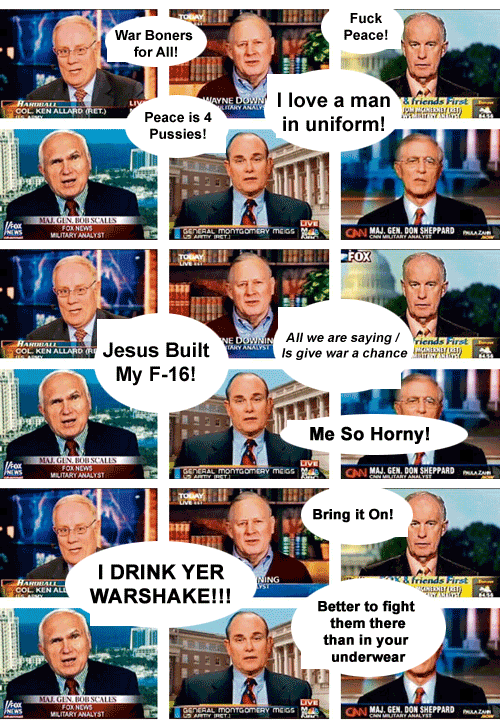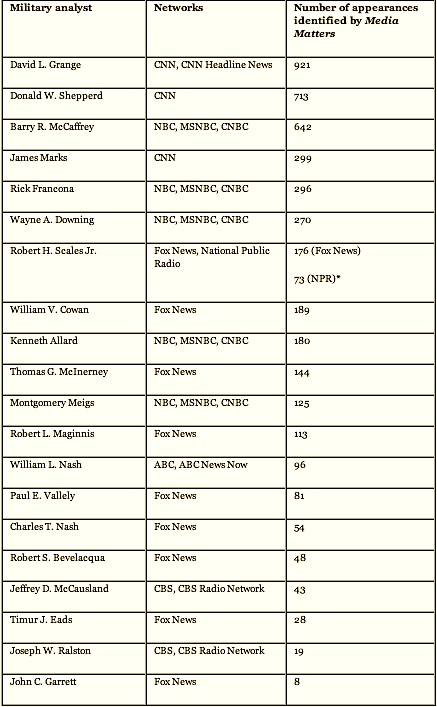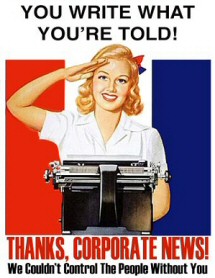
HUFFINGTON POST: In April, The New York Times published a story exposing the deep ties between numerous media military analysts and the Pentagon and defense industries. The Times noted that “the Bush administration has used its control over access and information in an effort to transform” media military analysts, many of whom have clients or work for companies with an interest in obtaining Pentagon contracts, “into a kind of media Trojan horse — an instrument intended to shape terrorism coverage from inside the major TV and radio networks.” HuffPost’s Jason Linkins noted at the time that neither the Times nor other major media outlets had worked to advance the story, or apologize for their role in potentially spreading government propaganda. Now, Media Matters has issued a report showing that the analysts program had a far wider reach than previously believed. MORE
 MEDIA MATTERS: On April 20, The New York Times published an article by investigative reporter David Barstow that detailed the connection between numerous media military analysts and the Pentagon and defense industries. Barstow reported that “the Bush administration has used its control over access and information in an effort to transform” media military analysts, many of whom have clients or work for companies with an interest in obtaining Pentagon contracts, “into a kind of media Trojan horse — an instrument intended to shape terrorism coverage from inside the major TV and radio networks.” A Media Matters review found that since January 1, 2002, the analysts named in Barstow’s article — many identified as having ties to the defense industry — collectively appeared or were quoted as experts more than 4,500 times on ABC, ABC News Now, CBS, CBS Radio Network, NBC, CNN, CNN Headline News, Fox News, MSNBC, CNBC, and NPR in segments covering the Iraq war both before and after the invasion, as well as numerous other national security or government policy issues. MORE
MEDIA MATTERS: On April 20, The New York Times published an article by investigative reporter David Barstow that detailed the connection between numerous media military analysts and the Pentagon and defense industries. Barstow reported that “the Bush administration has used its control over access and information in an effort to transform” media military analysts, many of whom have clients or work for companies with an interest in obtaining Pentagon contracts, “into a kind of media Trojan horse — an instrument intended to shape terrorism coverage from inside the major TV and radio networks.” A Media Matters review found that since January 1, 2002, the analysts named in Barstow’s article — many identified as having ties to the defense industry — collectively appeared or were quoted as experts more than 4,500 times on ABC, ABC News Now, CBS, CBS Radio Network, NBC, CNN, CNN Headline News, Fox News, MSNBC, CNBC, and NPR in segments covering the Iraq war both before and after the invasion, as well as numerous other national security or government policy issues. MORE
HUFFINGTON POST: An ongoing exploration of the documents related to the Pentagon’s “message force multipliers” program has unearthed a clip of former Defense Secretary Donald Rumsfeld suggesting that America, having voted the Democrats back into Congressional power, could benefit from suffering another terrorist attack, and doing so in the presence of the very same military analysts who went on to provide commentary and analysis of the Iraq War. As documented by Newsvine, it all went down at a valedictory luncheon Rumsfeld hosted for those analysts on December 12, 2006. Many of the “message force multipliers” named in the original New York Times piece were in attendance, including David L. Grange, Donald W. Sheppard, James Marks, Rick Francona, Wayne Downing, and Robert H. Scales, Jr. They were treated to an extraordinary conversation (Newsvine has highlights, the hour-long clip of which can be found here) with Rumsfeld, that included many jaw-dropping moments…But by far the most extraordinary part of this luncheon is the antipathy the gathered members exhibit toward the American people for having the temerity to vote the Democrats back into power. When Lt. Gen. Michael DeLong bemoans the lack of “sympathetic ears” on Capitol Hill, Rumsfeld offers that the American people lack “the maturity to recognize the seriousness of the threats.” What’s to be done? According to Rumsfeld, “The correction for that, I suppose, is [another] attack.” MORE
multipliers” program has unearthed a clip of former Defense Secretary Donald Rumsfeld suggesting that America, having voted the Democrats back into Congressional power, could benefit from suffering another terrorist attack, and doing so in the presence of the very same military analysts who went on to provide commentary and analysis of the Iraq War. As documented by Newsvine, it all went down at a valedictory luncheon Rumsfeld hosted for those analysts on December 12, 2006. Many of the “message force multipliers” named in the original New York Times piece were in attendance, including David L. Grange, Donald W. Sheppard, James Marks, Rick Francona, Wayne Downing, and Robert H. Scales, Jr. They were treated to an extraordinary conversation (Newsvine has highlights, the hour-long clip of which can be found here) with Rumsfeld, that included many jaw-dropping moments…But by far the most extraordinary part of this luncheon is the antipathy the gathered members exhibit toward the American people for having the temerity to vote the Democrats back into power. When Lt. Gen. Michael DeLong bemoans the lack of “sympathetic ears” on Capitol Hill, Rumsfeld offers that the American people lack “the maturity to recognize the seriousness of the threats.” What’s to be done? According to Rumsfeld, “The correction for that, I suppose, is [another] attack.” MORE
 POLITICO: Indeed, reporter David Barstow’s 7,600-word investigation of the Pentagon’s military analyst program — whereby ex-military talking heads, often with direct ties to contractors, parroted Defense Department talking points on the air — has been noticeably absent from television airwaves since the story broke on April 20. The Project For Excellence In Journalism tracked the mainstream media for a week after the Times story and found that out of approximately 1,300 news stories, only two touched on the Pentagon analysts scoop — both airing on PBS’s “NewsHour.” MORE
POLITICO: Indeed, reporter David Barstow’s 7,600-word investigation of the Pentagon’s military analyst program — whereby ex-military talking heads, often with direct ties to contractors, parroted Defense Department talking points on the air — has been noticeably absent from television airwaves since the story broke on April 20. The Project For Excellence In Journalism tracked the mainstream media for a week after the Times story and found that out of approximately 1,300 news stories, only two touched on the Pentagon analysts scoop — both airing on PBS’s “NewsHour.” MORE
HARRY SHEARER: Glenn Greenwald at Salon has read through the 8000 pages of transcripts the Pentagon released as a result of the NYT’s Freedom of Information Act lawsuit (the basis for the original Times story). He has two reports on what he’s read, here and here.
